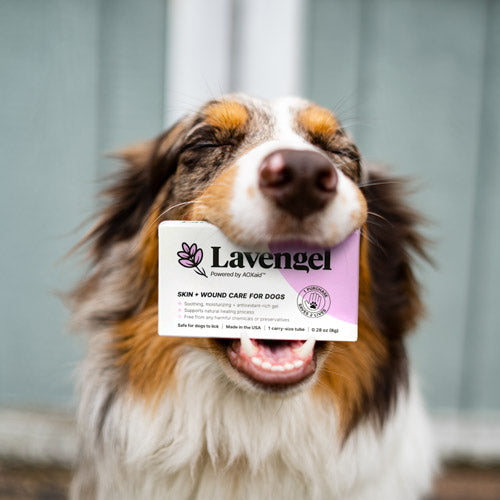Common Canine Skin Conditions, Issues + Diseases
Welcome to our library of various dog skin issues and disorders!
Want to figure out exactly what that weird spot is on your dog? Maybe you've heard of it, but would like more info. Either way, we can help!
We've even got a glossary of canine skin problems that you can access via the button below.
As a heads up, this information does not replace professional veterinary advice or consultation. It is simply an educational resource.
🎄 25% Off 🎄 Christmas Countdown Sale
Use code FELIZNAUGHTYDOG at checkout and get your dog, grand-dog, or your friend's dog the gift of relief!
-
Hot Spots
Talk about a hot topicAlso known as acute moist dermatitis, these angry and aggravatingly itchy red patches are no fun for any dog - or owner.
-
Paw Licking + Irritations
Dive in feet firstWhy do dogs lick their paws so much? We've found a wide array of reasons and irritations that make them treat their feet like lollipops.
-
Rashes + Dermatitis
Let's get rash-onalOften referred to interchangeably, dermatitis takes on different forms with different causes. Here is an overview of 11 common types.
-
Atopy + Skin Allergies
Itching to know more?Canine atopic dermatitis (atopy) is an immune response to allergens, creating inflammation, lots of itching, and a lifelong challenge.
-
Pyoderma + Bacterial Infections
Ew... tell me morePyoderma, aka bacterial skin infection, ranges from acne-like pimples to serious deep-tissue infections and can affect all dogs at all ages.
-
Yeast Infections
The yeast we like leastDid you know the primary cause of nearly all yeast dermatitis and ear and paw yeast infections in dogs is a single fungus called Malassezia?
-
Ringworm
A germ and not a worm?Despite its name, ringworm is not a worm or a parasite. It is a fungus that attacks hair follicles and is highly contagious to dogs and humans alike.
-
Mange: Demodex + Scabies
Mite be worth looking intoWhat is mange, and what causes it? How is it treated? Can I get mange from my dog? We've got many mange questions covered.
-
Warts
Welcome to DogwartsWarts, or papillomas, are ugly benign tumors that can appear almost anywhere on the body - including inside your dog's mouth!
-
Itchy Ears + Otic Infections
Come see what's in hearIf your dog is constantly scratching their ears or shaking their head, there may be a sound reason, or possibly an ear infection.
-
Intertrigo
Know when to foldMore commonly known as skin fold dermatitis, this irritating skin issue tends to affect wrinkly breeds, though obese dogs are at risk as well.
-
Seborrhea
Don't trust the crustSeborrhea is a disorder that affects keratin and skin cell replenishment. It can resemble scaly, chunky dandruff that's oily and smelly.
-
Burns
I'm burning for learningLearn how burns are different than other wounds, as well as how you can treat minor burns on your dog at home with Lavengel®.
-
Cysts
Re-cyst-ance is futileThese pockets of fluid or semi-fluid matter are typically harmless and slow-growing, but they are best dealt with sooner rather than later.
-
Frito Feet
Please corntinueIs it bad when a dog's feet smell like a bag of corn chips? Should you be concerned? Let's get out the salsa and guacamole and find out.
-
Walking Dandruff
More like dand-roughFormally known as cheyletiellosis, this heavy dandruff disorder is caused by mites that can look like moving skin flakes to the naked eye.
Dog Skin Issues Glossary
Find definitions of many of the common (and not-so-common) skin problems and woes that affect our furry amigos.
Collapsible content
Acral lick dermatitis (lick granuloma)
Acral lick dermatitis, more commonly known as lick granuloma, is similar to acute moist dermatitis, appearing as a wet area with missing fur and pink/red skin that is caused by repeated licking at a specific area - typically on the legs, feet, or tail.
Lick granulomas can begin as a reaction to an itch, irritation, injury, arthritis, or joint pain, and they can even sometimes manifest as a product of anxiety or a behavioral fixation.
Acute moist dermatitis (hot spot)
Acute moist dermatitis, also referred to as pyotraumatic dermatitis or hot spot, refers to a red, inflamed, often moist and shiny lesion that is created by consistent trauma to a specific area - usually via a dog's licking, chewing, scratching, and/or rubbing a specific itch or irritation.
Acute moist dermatitis can be brought on by skin allergies, parasites, insect bites, bee or wasp stings, injury, trapped moisture, or friction from a collar or harness.
Canine hot spots are extremely itchy and can be very painful. If left untreated, they can easily become infected and grow worse.
Learn more and see examples on our Dog Hot Spot Resource page.
Atopy + atopic dermatitis
Atopy, otherwise known as atopic dermatitis, allergy dermatitis, or eczema, is is an allergy-derived skin condition that creates inflammation and chronic, excessive itching in various parts of the body.
Atopy is very common and can be a seasonal or year-round skin condition.
Learn (much) more about atopy in our Dog Skin Allergies and Atopic Dermatitis Resource.
Contact dermatitis
Contact dermatitis is much like - and often is - allergy dermatitis, appearing when the skin comes into contact with a specific irritant, such as an allergen or a chemical substance like floor cleaners or pesticides.
Contact dermatitis may also arise from friction, for example, from a rubbing collar, leash, or harness.
Cyst
Cysts are hollow spaces or sacs within the skin that contain liquid or semi-liquid matter. This matter could be natural or abnormal secretions of sweat, sebum, dead tissue cells, blood, or keratin.
Cysts come in several types, based on their structure, location, and cause:
- True
- False
- Dermoid
- Follicular
- Sebaceous
- Interdigital
Learn more and view examples of cysts on dogs on our Canine Cysts page.
Demodicosis (demodex mange)
Demodicosis, also known as demodectic, demodex, or red mange, is a parasitic infestation of microscopic mange mites of the Demodex genus.
These mites dwell in the hair follicles adn sebaceous glands of many dogs and are kept in check by the dog's immune system. If the immune system is underdeveloped or weakened, demodicosis can occur.
Between the two forms of mange in dogs, demodicosis is the more frequent. It occurs most often to puppies less than 18 months old, dogs with underlying health issues, or senior dogs with weaker immune systems.
Learn more about mange in our Mange in Dogs Resource.
Dermatitis
Dermatitis refers to inflammation in the skin, which is caused by the immune system's response to a determined threat or irritant that a dog has inhaled, ingested, or has allowed to breach the skin barrier.
There are many different types of dermatitis. You can see and learn about 11 forms with photo examples on our Canine Rash and Dermatitis Resource page.
Dermatophytosis (ringworm)
Dermatophytosis, or ringworm, is a disease with spreading lesions of fur loss that is caused by an infection of one of three different types of fungus:
- Microsporum canis
- Microsporum gypseum
- Trichophyton metagrophytes
These fungi are contracted by contact and feed on dead skin, nails, and hair follicles.
In dogs, infected areas can appear as circular patches of hair loss, or amorphous, spreading patches of hair loss. Itching can be mild to severe - likely depending on whether a compound infection is present. Hair within the lesions and infected nails are often dry and brittle.
Ringworm can be tough to get rid of and requires isolating the dog, consistent treatment, and a deep cleaning of all surfaces that the dog has come into contact with.
Learn more about dermatophytosis and see photo examples on our Canine Ringworm Resource page.
Folliculitis
Folliculitis is a type of superficial pyoderma referring to the inflammation of a hair follicle(s) that is caused by bacteria (most common), fungi, parasites, or injury.
Folliculitis may manifest as pimples, pustules, small sores, or scabs on the dog's skin. In certain cases where the hair follicle sustains significant damage, a follicular cyst may appear.
You can see an example of folliculitis on our Canine Rash and Dermatitis Resource page.
Impetigo
Impetigo is a form of superficial pyoderma that affects puppies, typically appearing as red bumps or pimples on a puppy's belly.
Like most forms of canine pyoderma (bacterial skin infection), impetigo is commonly caused by Staphylococcus pseudintermedius bacteria.
Intertrigo
Intertrigo in dogs refers to skin fold dermatitis, frictional dermatitis, skin fold pyoderma, which is inflammation and irritation that forms between two contacting folds of skin.
Intertrigo tends to affect breeds with skin folds, short-snout breeds (bullies), obese dogs, whole male dogs, and female dogs that have had puppies.
Allergies and microbial growth between these folds further exacerbate itch and irritation.
Skin fold dermatitis affects several areas, and can be categorized by its location:
- Facial fold
- Lip fold
- Neck and body folds
- Tail fold
- Scrotal and vulval fold
Learn more about canine intertrigo on our Dog Skin Fold Dermatitis Resource page.
Malassezia (yeast) dermatitis
Malassezia dermatitis, also known as a yeast infection of the skin, involves an overgrowth of the fungus Malassezia pachydermatis, which naturally dwells on the surface of a dog's skin. The vast majority of all canine yeast infections of the skin and ears are caused by Malassezia fungi, so the terms are often interchangeable.
A Malassezia infection of the ears is referred to as Malassezia or yeast otitis.
Learn more about canine yeast infections and see what they look like on our Guide to Malassezia in Dogs and our Canine Otic Infection Resource.
Otitis
Otitis refers to inflammation and/or infection of the ears. It is usually distinguished as otitis externa (outer ear), otitis media (middle ear), and otitis interna (inner ear).
Learn more about canine otitis and otic infections in our Itchy Ear and Dog Otitis Resource.
Papillomas (warts)
Papillomas, or warts, are benign skin tumors brought about by the canine papilloma virus (CPV).
Once CPV invades the skin cells, the virus upsets the regular cell division process and causes cells to divide at a more rapid, irregular rate, causing cauliflower or sea-anemone-like papillomas to grow until the dog's immune system can get the virus under control.
Warts can occur anywhere on a dog's body, but they tend to appear on dogs in areas like:
- Inside and around the mouth
- Genitals
- Eyelids
- Ears
- Between toes.
Learn more about canine papillomas and see examples in our Warts on Dogs (Dogwarts) Resource.
Psoriasis
Psoriasis is a chronic condition in which the immune system becomes overactive, causing skin cells to multiply too quickly and create inflamed, often scaly and red patches of skin.
Psoriasis is not recognized as a true disease in dogs, and to date, there have been scarce cases that have been officially diagnosed as psoriasis.
There are several known skin maladies that affect dogs which resemble psoriasis, such as:
- Atopic / allergy dermatitis
- Flea allergy dermatitis
- Mange mites
- Cheyletiella mites (walking dandruff)
- Dermatophytosis (ringworm)
- Malassezia (yeast) dermatitis
- Pyoderma
Pyoderma
Pyoderma means "pus in the skin," and is generally used to refer to a bacterial infection in the skin.
The great majority of all canine pyoderma cases are caused by an overgrowth of the bacteria Staphylococcus pseudintermedius.
Fun fact: Lavengel® has a patent for its ability to inhibit and kill Staph bacteria, including the S. pseudintermedius species and its drug-resistant form.
Pyoderma is classified based on its depth:
- Surface - affecting only the epidermis
- Superficial - affecting to the hair follicles
- Deep - affecting the dermis
Learn more about mange in our Complete Dog Pyoderma Resource.
Scabies (sarcoptic mange)
Scabies, or sarcoptic mange, is a parasitic infestation of the Sarcoptes scabiei mite.
These mites are typically picked up from other infected animals, where they burrow into the skin, feed on dead skin and hair, and reproduce.
Scabies are extremely itchy and can result in fur loss, redness, darkened skin lesions (hyperpigmentation), hardened skin (lichenification), infection, and if untreated, eventual death.
Learn more about sarcoptic mange in our Mange in Dogs Resource.
Seborrhea
Scabies, or seborrheic dermatitis, is a skin disease caused by an abnormal production of keratin, a key protein that forms skin and hair.
Keratin is produced and shed in a cycle, and in dogs with seborrhea, that cycle is greatly accelerated. This creates a keratin buildup on the skin, which resembles flakes (dandruff) or chunky yellow or gray scales on the skin.
Seborrhea can be categorized as primary or secondary.
Primary seborrhea is acquired genetically and cannot be cured, but it can be managed.
Secondary seborrhea - the more frequent form - typically arises due to another issue, such as allergies, infection, parasites, hormonal disorder, or autoimmune condition.
Learn more about canine seborrhea and view examples in our Seborrhea in Dogs Resource.


